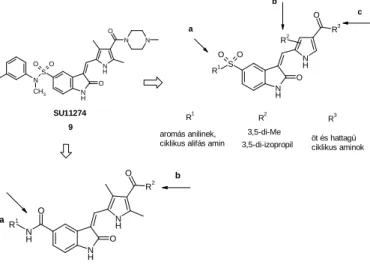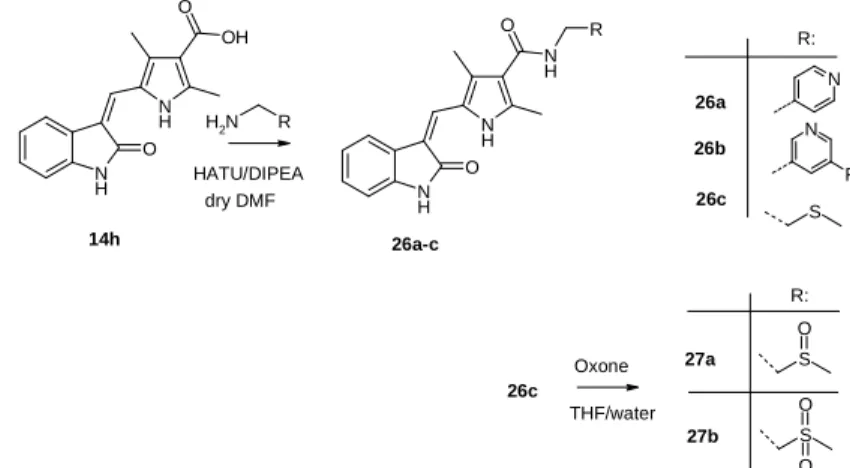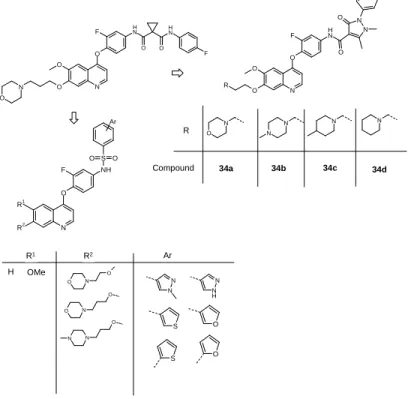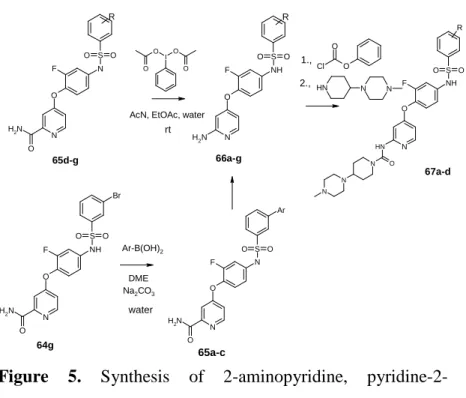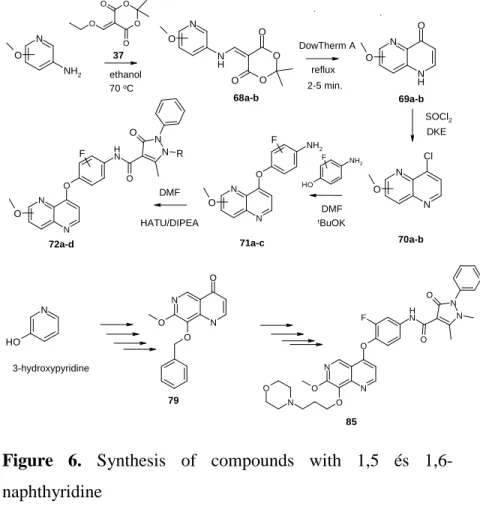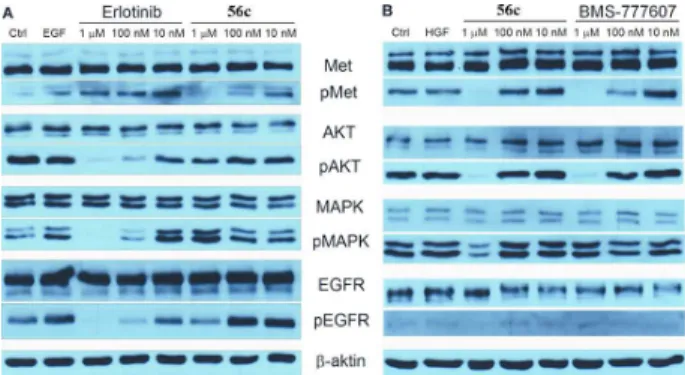Synthesis and Biochemical Testing of Multikinase Inhibitors Targeting c-Met and EGFR
Ph.D. Thesis
Bálint Szokol
Semmelweis University
Doctoral School of Pharmaceutical Sciences
Supervisor: Dr. György Kéri, Professor, D.Sc.
Opponents: Dr. Sándor Hosztafi, C.Sc.
Dr. Zsuzsa Majer, Ph.D.
Chair of the examination committee: Dr. Kornélia Tekes, PhD Members of the examination committee: Dr. Péter Huszty, DSc.
Dr. Imre Klebovich, DSc.
Budapest
1. Introduction
The main aim of our research was to synthesize new compounds that inhibit two potential driver oncogenic kinases (EGFR and c-Met) preventing the emergence of acquired resistence against selective inhibitors that act on the kinases separately and which also control the multiplication of resistant tumor cells. The novel compounds were developed based on the structure of known molecules by combining compound libraries, using in silico calculations and docking methods. During my scientific work derivatives were successfully developed that can be linked to platinum-based carriers, thus enabling them to be used in cell-selective bioconjugates.
1.1. Status and therapy of tumorous illnesses
The diagnosis and treatment of tumorous illnesses have posed a challenge for the medical sciences for a long time and even today 1.6 million new patients are registered annually in the United States and approximately 70 000 patients in Hungary.
The most common tumorous illness in males is epithelial lung cancer, while in case of women lung cancer follows breast cancer in frequency. Cancer cells commonly use phosphorylate kinase enzimes in their signalling pathways as
survival signals, inhibition of which can arrest multiplication, under favorable circumstances cells can be distroyed.
Therefore, over the last decade kinases have become the most frequent therapeutic targets of cancer treatment, as a result of which there are twenty six kinase inhibitor drugs currently on the market and there are several hundred kinase inhibitors under clinical trials. In the course of the research program of Cancer Genome Atlas that was launched in 2005 several hundreds of genetic mutations were discovered, which served as a milestone for the development of numerous novel anti- cancer medicines. According to the information gathered to date, there are 138 registered driver genes (64 oncogene and 74 tumor supressor genes) that are responsible for tumor- formation, which cover 12 signaling pathways.
1.2. Emergence of acquired resistance
It has been observed that in a group of patients who react to EGFR inhibitor therapy, relatively soon resistance occurs and EGFR inhibitors become completely ineffective. One of the most frequent reasons is the so-called T90M mutation (responsible for tyrosine/methionine replacement), which can
responsible (approx. 5%). Acquired resistance can develop not only due to mutant EGFR, but also by using alternative pathways to activate EGFR (oncogene switch) making the tumor cell independent of EGFR. In tumors of NSCLC (non- small cell lung cancer) c-Met amplification occurs in 18-20 % of the cases, which leads to the activation of the erlotinib/gefitinib-resistant PI3K signaling pathway, while the pathway becomes dependant on HER3 which is related to the EGFR kinase. The interrelatedness of c-Met, EGFR and HER3 has been proven by numerous research and it has become clear that inhibiting one oncogene is not sufficient in such tumors; only by using dual c-Met/EGFR inhibitors can tumor cells be destroyed.
1.3. Cell-specific bioconjugates
Most of the kinase inhibitors under clinical development are wide-spectrum inhibitors which is beneficial in terms of resistance against drugs but disadvantageous due to probable side-effects. These side-effects limit clinical use; however, they can be significantly reduced by using cell- or organspecific carriers. The most common carriers are liposomes and macromolecular conjugates, with the help of which the drug, wrapped in liposome or linked to a carrier,
can target a specific organ. A novel approach is the development of compounds that can be linked to non-toxik platinum-carriers. With the help of ULS™ bioconjugates can be prepared to which a drug molecule, an antibody, a macromolecule responsible for the release of the active substance or a cell-specific macromolecule can be linked at the same time making the bioconjugate organ- and cell- selective.
2. Aims
The main aim of my scientific work was to develop novel compounds that inhibit both EGFR and c-Met kinases. My objective was to synthesize clinically relevant c-Met inhibitors that could later be used in enyzme and cellular assays as reference compounds and by modifying these structures I tried to synthesize derivatives that can inhibit both kinases. The binding mode of the compounds were investigated with computerised predictions. An other aim of my work was to synthesize derivatives that can be linked to platinum-based carriers.
3. Methods
3.1. Biological, chemical and in silico methods
The reference compounds, their derivatives and the novel, structurally different compounds were prepared by classical chemical methods as described in the literature or analogously. As a first step, the compounds were tested by in vitro enzymatic assays; subsequently, the effective compounds were tested on clinically relevant tumor cell lines.
The most effective compounds were characterised by classical biochemical methods (Western blot analysis, FACS, enzyme kinetic tests). For the docking experiments X-ray crystallographic data found in the literature were used.
3.2. Synthesis of c-Met inhibitor reference compounds For the validation of cellular and enzymatic assays reference compounds were neccessary; therefore, two c-Met inhibitors SU11274 (9) and foretinib (33) were synthetised (Figure 1).
N H
O O
NH
F
N O
O R
F
N O NH
N O
N
NH O S
O O N CH3 Cl
SU11274 9
foretinib 33
Figure 1. c-Met kinase inhibitor reference compounds
3.3. Setting up a focused chemical compound library A focused compound library was set up modifying the structure of SU11274 in three different places (Figure 2.).
N H
N O
N
N H
O S
O O N CH3 Cl
NH O S
O O R1
NH R3 O
R1 R2 R3
R2
R2
NH O
NH O O
NH R1
SU11274
9 aromás anilinek,
ciklikus alifás amin
3,5-di-Me
3,5-di-izopropil öt és hattagú ciklikus aminok a
b
c
a
b
Figure 2. Structural modifications of SU11274
The structure of the reference compounds were modified as follows: a. the aniline of 5-sulphonamide, b. the alkyl of the pyrrole alkyl-group, c. the pyrrole carboxamide.
As the next step, the 5-sulphonamide motifwas replaced by a 5-carboxamide motif, while the 5-carboxamide (a) and the pyrrole-carboxamide (b) motifs were modified (Figure 2).
3.4. Preparation of compounds that can be linked to Pt- carriers
Based on the structure of sunitinib (Sutent®) compounds were synthesized that can be linked to Pt(II)-carriers. A pyridine- ring was built on the core of sunitinib making it possible to form a complex with platinum.
NH
NH O
O OH
NH
NH O
O NH
R
N H2 R
N N
F S
S O
S O O 14h
HATU/DIPEA dry DMF
26a-c
27b R:
26a 26b 26c
THF/water Oxone
R:
27a 26c
Figure 3. Preparation of compounds that can be linked to carriers
3.5. Derivatives with 4-phenoxyquinoline structure
A focused compound library was set up by modifying the structure of foretinib in twoplaces (on the side-chains in positions 6 and 7 and on the carboxamide scaffold)
N H
O O
N H
F F
N O
O O
N O
N
N N N
O N
O N O N N H
N O F
O
R O
N O
F NH
S
O O
R2 R1
Ar
O N
O
O N
O
N N
O
N N
NH N
S O
S O
R
Compound 34a 34b 34c 34d
R1 R2
H OMe
Ar
Figure 4. 4-fenoxiquinoline structure containing compounds
3.6. 2-Aminopyridine, pyridine-2-carboxamide and 2-urea derivatives
Starting from structure of c-Met inhibitor BMS777607 and golvatinib I have prepared derivatives containing 2- aminopyridine scaffold to develop further c-Met/EGFR inhibitors.
N O
F NH
S
O O
N H2
O
Br
N O
F N
S
O O
N H2
O
Ar N
N H2
O
F NH
S
O O
O I O O O
N O
F N
S
O O
N H2
O
Cl O O
N
H N N
R
N H
N O
N N
N O
F NH
S
O O
R R
DME Na2CO3
water Ar-B(OH)2
64g 65a-c
AcN, EtOAc, water rt
66a-g
1., 2.,
65d-g
67a-d
Figure 5. Synthesis of 2-aminopyridine, pyridine-2- carboxamide and 2-urea derivatives
3.7. Compounds with 1,5 and 1,6-naphthyridine structure
During my research compounds with 1,5 and 1,6- naphthyridine core, which is bioisostere with quinoline, were also prepared.
N
NH2
O O O
O O
O O O
O N
NH
N
NH O
N
N Cl
N
N O
NH2
N
N O
NH O
N O N
R
F F
O H
NH2
F O
O
O
O
O
O
N
O H
N N O
O O
N N O
O N F H
O N
N O O N O ethanol
70 oC
reflux 2-5 min.
SOCl2 DKE
68a-b 69a-b
71a-c
DowTherm A
DMF
tBuOK HATU/DIPEA
DMF 37
70a-b 72a-d
3-hydroxypyridine
79
85
Figure 6. Synthesis of compounds with 1,5 és 1,6-
4. Results
4.1. Inhibition of c-Met, EGFR and InsR kinases and effects on the viability of HCC827 and H1993 cell-lines For the c-Met and EGFR enymatic assays various EGFR inhibitors (erlotinib, afatinib) and c-Met inhibitors (crizotinib, BMS777607) were used. Compounds containing indole-2-on and 2-aminopyridine cores were not effective on the c-Met kinase; in consequence, these were not tested further. From among compounds with 1,5- and 1,6-naphtyridine cores only compound 72a (IC50 = 32 nM) and compound 72d (IC50 = 445 nM) showed c-Met inhibition.
Compounds with 4-fenoxiquinoline core were the most effective. Derivatives based on the structure of foretinib showed extremely low inhibition both in enzymatic and cellular assays. (34a-d c-Met IC50 = 5 nM, 7nM, 15 nM és 20 nM, illetve H1993 IC50 = 5 nM, 2nM, 30nM és 74 nM respectively.) It is a disadvantage that in low concentrations (InsR IC50 < 200 nM) they showed inhibition of the InsR and the NIH3T3 cell line (IC50 = 45-74 nM). Replacing the carboxamide motif with a sulfonamide motif resulted in decreased c-Met inhibition but increased EGFR inhibition.
Three compounds proved to be the most effective (56a c-Met
IC50 = 564 nM, EGFRwt IC50 = 84 nM; 56b c-Met IC50 = 1048 nM, EGFRwt IC50 = 168 nM; 56c c-Met = 398 nM, EGFRwt IC50 = 94 nM). In cellular assays compound 56c showed an inhibition of IC50 = 1,94 μM on the HCC827 cell line, and IC50 = 1,35 μM on the H1993 cell line.
Structure - Activity Relationship
Compounds with quinoline core have the following structural elements that are responsible for c-Met and EGFR inhibition:
a. a side-chain of three carbon atoms in position 7 containing 1-methylpiperazine
b. in position 3 of the biaryl-sulfonamide motif a five- membered, heteroaromic ring is necessary
c. the most effective of the tested compounds were the ones containting an 1-methyl-1H-pyrazole-4-il ring (56a), 3-furyl ring (56b) and 3-thenyl ring (56c) in position 3. Derivatives without a side-chain showed no
4.2. Testing of the most effective compounds
To investigate possible toxic side-effects compound 56c (3- tienil) was was screened on a recombinant kinase selectivity panel which contained 34 clinically relevant kinases.
Although the compound inhibits multiple kinases, there were six - DDR1 (111 %), AXL (109 %), cKIT (91 %), ErbB2 (81
%), RET (78 %) and FLT3 (76 %) inhibition of which was over 75 % at 1 µM compound concentration. The compound was found to be ATP-competitive. EGFRwt and c-Met enzyme activity (Vmax) was measured at various ATP and kinase inhibitor concentration, the results of which were demonstrated on a Lineweaver-Burk double reciprocal graph.
4.3. Western blot analysis
In order to find out whether the compounds inhibit phosphorylation of the two enymes intracellularly as well, Western blot analysis was used. Compound 56c 3-thenyl derivative significantly inhibited c-Met and EGFR phosphorylation intracellularly and inhibited autophosphorylation of the members of PI3K-Akt-mTOR, Ras-Raf-Mek-MAPK signaling pathways.
7. ábra Western blot analysis of compound 56c
4.4. Scattering test
The motility of tumor cells and their capacity for metastasis were analysed with the help of scattering test of the prostate tumor DU145 cell line. It was found that the derivative 56c inhibited HGF-induced scattering of tumor cells at IC50 ~ 1,1 µM concentration.
4.5. Platinum-linked derivatives
Compound 26a, a pyridine derivative proved to be the most suitable to be linked to ULS™. The yield of the complex was high; furthermore, splitting with potassium-thiocyanate matched the expectations. The complex linked to modified lysozyme showed a 28-fold enrichment on HK2 immortalized
5. Conclusions
Based on the results described the following statements can be made:
1. I have synthesized c-Met inhibitors SU11274 and foretinib (XL-880). The structure of SU11274 was modified in three places (5-benzenesulfonamide, a pyrrole 3,5-alkyl, and pyrrole-3-carboxamide), while a foretinib was modified in two places (in positions 6 and 7 of the quinoline ring and in position 3 of the benzenesulfonamide motif).
2. By modifying the structure of foretinib in two places I obtained derivatives that inhibit c-Met and EGFR in submicromolar IC50 values. The quinoline core was replaced with 2-aminopiridin, 1,5- and 1,6-naphtyridine;
however these proved to be ineffective as dual inhibitors.
During our synthetic work, I prepared 130 novel compounds.
3. Building the antipyrine-carboxamide structural element that can be found on the clinical c-Met inhibitor, AMG- 458 on the foretinib anilines, I prepared extremely effective c-Met inhibitors that inhibited the H1993 tumor
cell line in low nanomolar IC50 values; however, they inhibited the insulin receptor as well.
4. The 4-fenoxiquinoline derivatives showed dual c- Met/EGFR inhibition in enzyme assays, while InsR receptor was less affected. The prominent compound (56c) inhibited six out of 34 kinases over 75 %.
5. Western blot analysis showed that the prominent compound inhibits autophosphorilyation of c-Met and EGFR on EGFR amplified HCC827 and c-Met amplified H1993 cell lines; moreover, it induced apoptosis on the HCC827 cell line effectively.
6. I have synthesized derivatives that can be linked to platinum-based carriers, to which ULS ™ can be linked successfully and bioconjugates can be prepared. Tests showed that the bioconjugate amplifies satisfactorily in HK2 cells.
Based on the struture-activity relationship and the biochemical characterization of the compounds, it can be stated that the compounds synthesized during my doctoral
6. List of own publications
1. Bálint Szokol, Pál Gyulavári, Ibolya Kurkó, Ferenc Baska, Csaba Szántai-Kis, Zoltán Greff, Zoltán Őrfi, István Peták, Kinga Pénzes, Robert Torka, Axel Ullrich, László Őrfi, Tibor Vántus, and György Kéri. (2014) Discovery and Biological Evaluation of Novel Dual EGFR/c-Met Inhibitors.
ACS Medicinal Chemistry Letters, 5 (4): 298–303. (IF: 3.311)
2. Kenessey I, Keszthelyi M, Krámer Z, Berta J, Adám A, Dobos J, Mildner M, Flachner B, Cseh S, Barna G, Szokol B, Orfi L, Kéri G, Döme B, Klepetko W, Tímár J, Tóvári J.
(2010) Inhibition of c-Met with the specific small molecule tyrosine kinase inhibitor SU11274 decreases growth and metastasis formation of experimental human melanoma. Curr Cancer Drug Targets. 10 (3):332-42. (IF: 4.771)
3. Harmsen S, Dolman ME, Nemes Z, Lacombe M, Szokol B, Pató J, Kéri G, Orfi L, Storm G, Hennink WE, Kok RJ. Development of a cell-selective and intrinsically active multikinase inhibitor bioconjugate. (2011) Bioconjug Chem.
22 (4): 540-5. (IF: 4.930) Articles in Hungarian
4. Szokol Bálint, Gyulavári Pál, Kurkó Ibolya, Baska Ferenc, Szántai-Kis Csaba, Greff Zoltán, Őrfi Zoltán, Peták István, Axel Ullrich, Őrfi László, Vántus Tibor, Kéri György.
(2013) Acta Pharmaceutika Hungarica, 83 (4): 121-133.
Other publications:
Ho HK, Német G, Ng YR, Pang E, Szántai-Kis C, Zsákai L, Breza N, Greff Z, Horváth Z, Pató J, Szabadkai I, Szokol B, Baska F, Őrfî L, Ullrich A, Kéri G, Chua BT. Developing FGFR4 inhibitors as potential anti-cancer agents via in silico design, suppor.ted by in vitro and cell-based testing. (2013) Curr Med Chem.20 (10):1203-17. (IF: 4.070)
Dolman ME, van Dorenmalen KM, Pieters EH, Sparidans RW, Lacombe M, Szokol B, Orfi L, Kéri G, Bovenschen N, Storm G, Hennink WE, Kok RJ. Dendrimer-based macromolecular conjugate for the kidney-directed delivery of a multitargeted sunitinib analogue. (2012) Macromol Biosci.
12 (1):93-103. (IF: 3.742)
Dolman ME, Harmsen S, Pieters EH, Sparidans RW, Lacombe M, Szokol B, Orfi L, Kéri G, Storm G, Hennink
to renal proximal tubular cells.(2012) Int. J. Nanomedicine.
7:417-33.(IF: 3.463)
Varga Z, Berényi S, Szokol B, Orfi L, Kéri G, Peták I, Hoell A, Bóta A. A closer look at the structure of sterically stabilized liposomes: a small-angle X-ray scattering study.(2010) J. Phys Chem B. 114 (20):6850-4. (IF: 3.603)
Székely R, Wáczek F, Szabadkai I, Németh Hegymegi- Barakonyi B, Eros D, Szokol B., Pató J, Hafenbradl D, Satchell J, Saint-Joanis B, Cole ST, Orfi L, Klebl BM, Kéri G.(2008) Immunol Lett. 116 (2):225-31. (IF: 2.858)
Pete B, Szokol B., Toke L. A facile synthesis of 5(6)- (klórmethyl)benzimidazoles: Replacement of a szulfonic acid functionality by chlorine. (2008) J. Het. Chem. 45:(2) 343- 347. (IF: 0.899)
Pete B, Szöllösy Á, Szokol B. A facile synthesis of 4-, 6-, and 7-formyl-1H-indole-2-carboxilates: the CH2SO3H functionality as a masked formyl group (2006) J. Het. Chem 43: (5) 1331–1335. (IF: 0.776)
